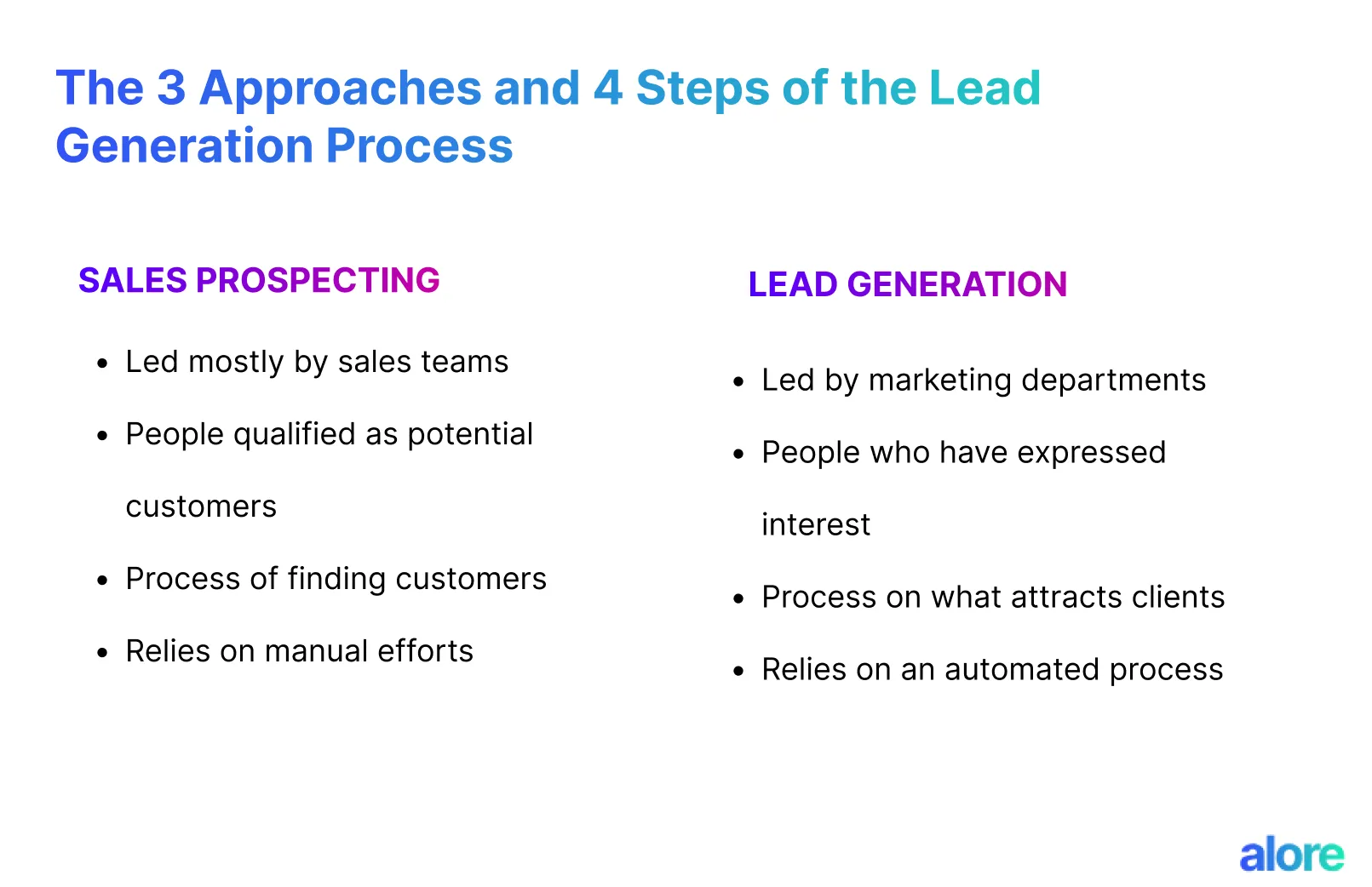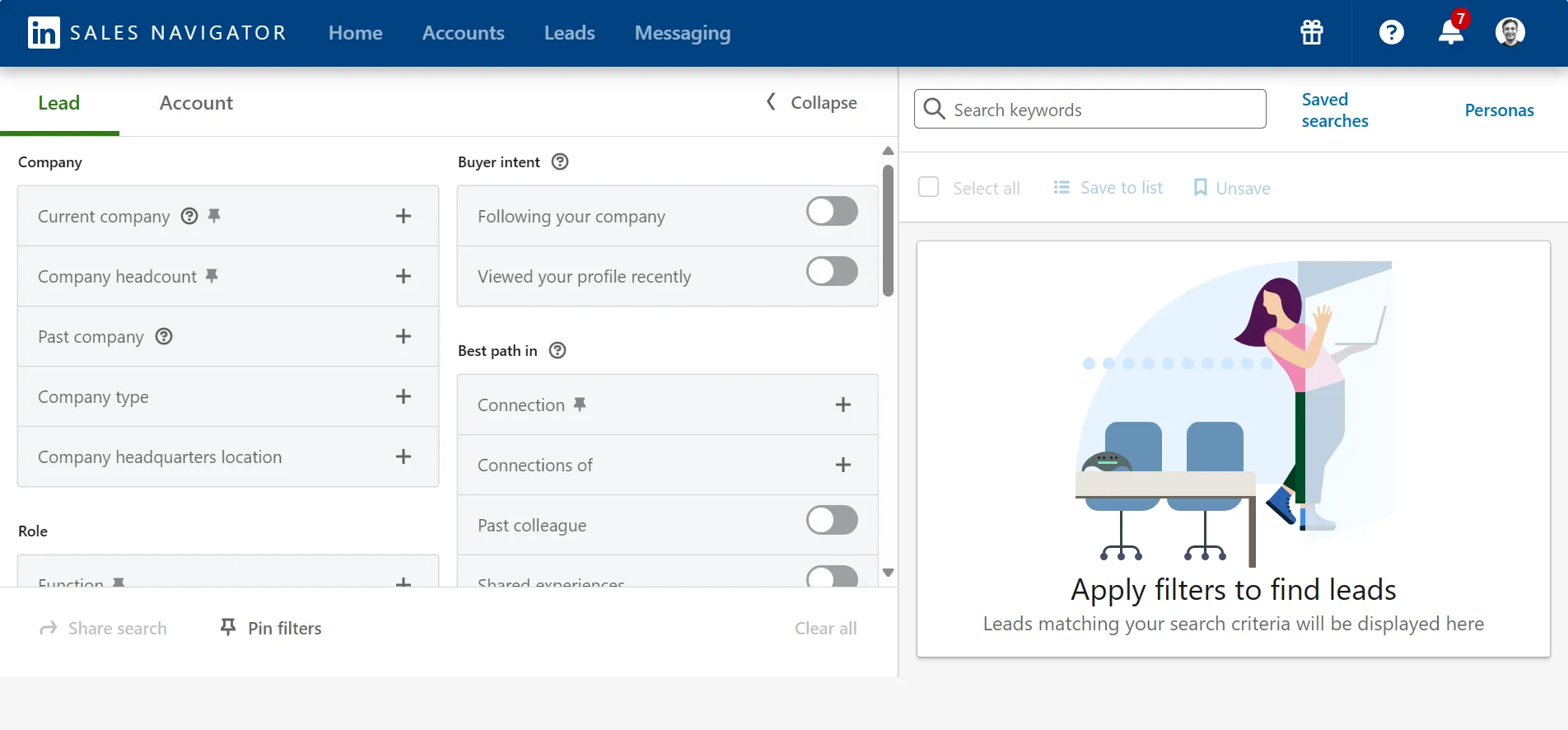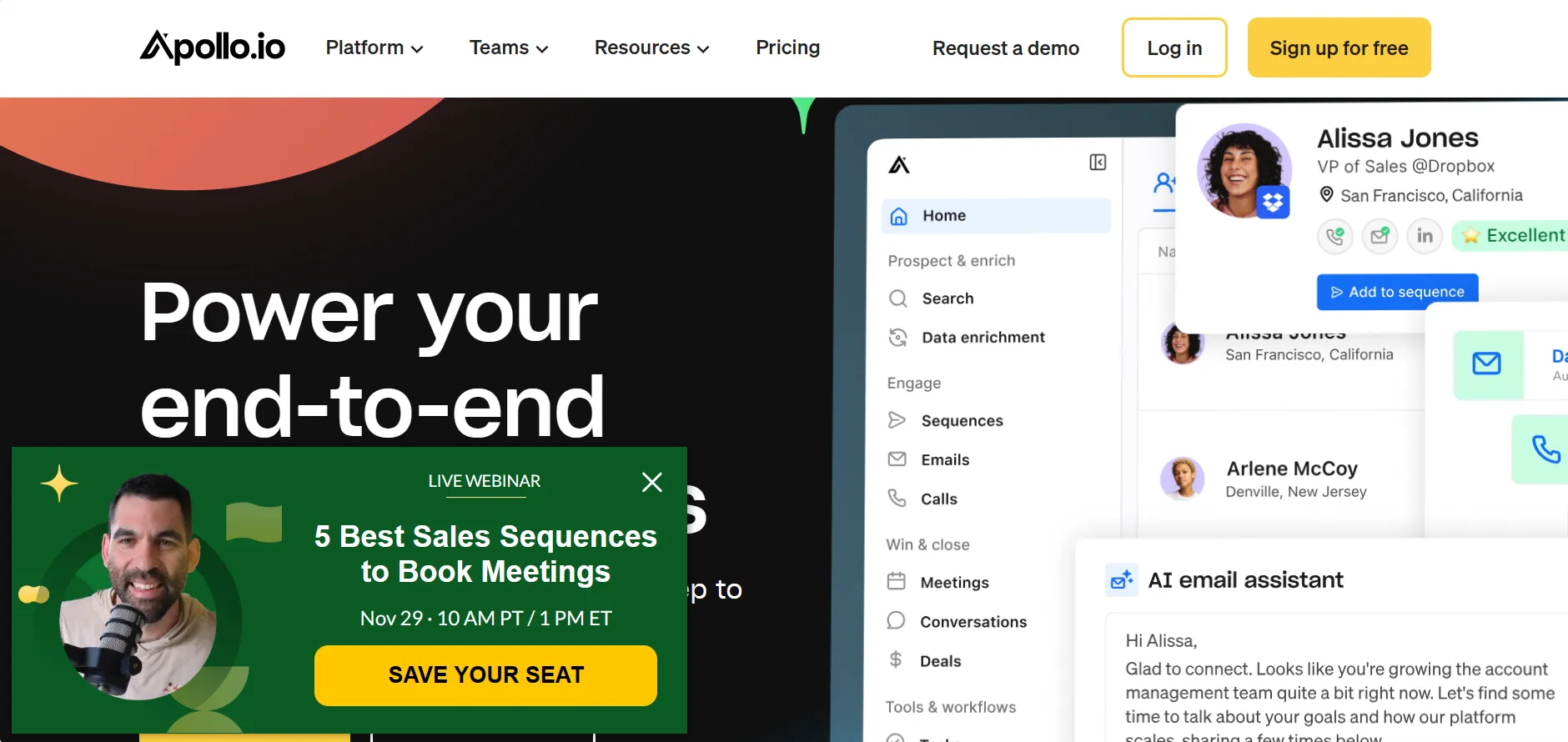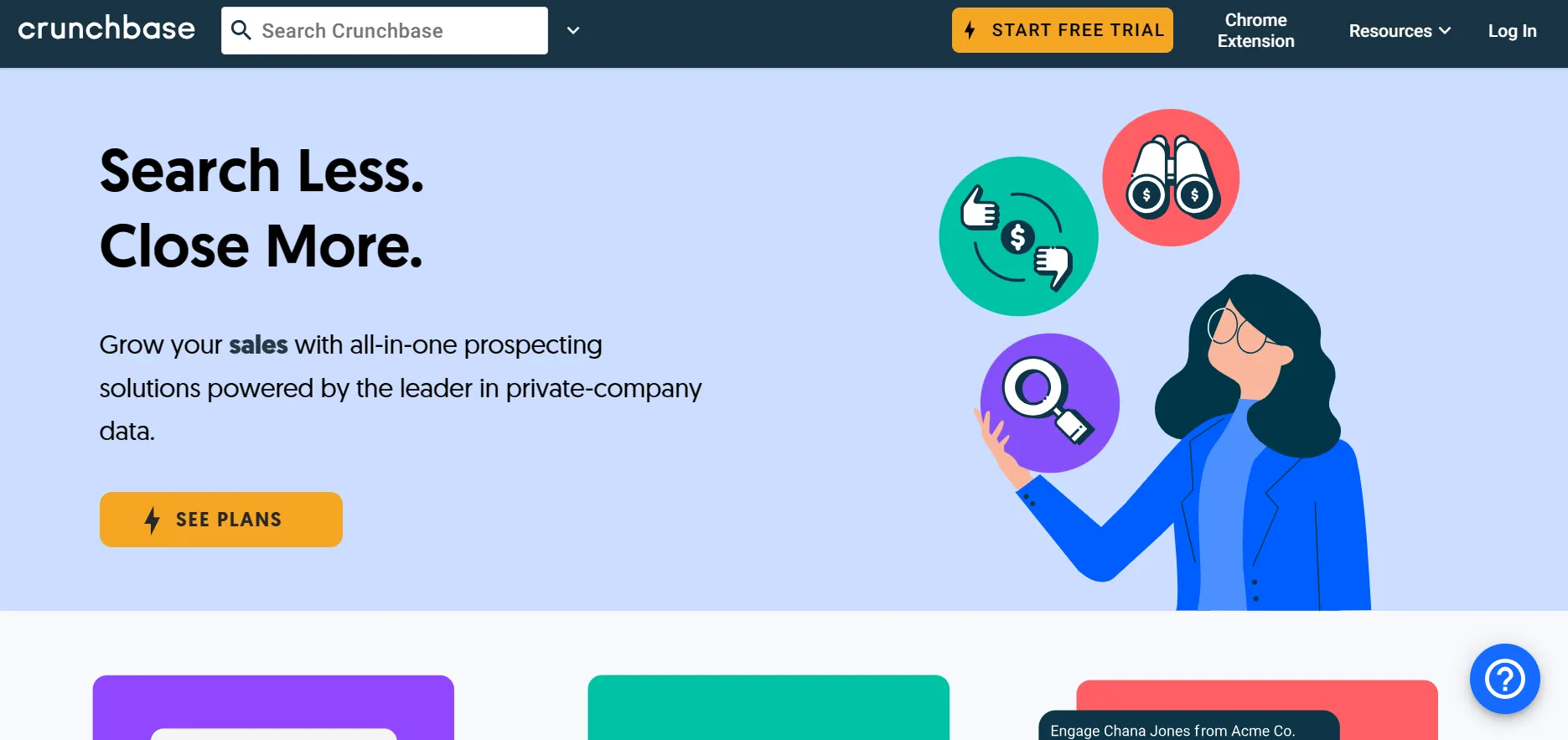Introduction to Sales Prospecting

Sales prospecting, the driving force behind successful sales operations, is often the first step where potential leads are identified, setting the stage for all subsequent sales efforts.
According to HubSpot, effective prospecting can improve sales productivity by up to 27%, underscoring its essential role in sales.
The Importance of Prospecting in Sales
Prospecting is not just the initial step in the sales process; it's crucial for business success.
Identifying and engaging with potential customers who match your product or service is not just about increasing conversion likelihood; it ensures resource efficiency.
Salesforce reports that high-performing sales teams use prospecting to enhance their win rates by as much as 15%.
Prospecting is about quality over quantity.
It's finding those potential buyers whose needs align with what you offer, thereby increasing the chances of successful sales.
This approach helps in optimizing the efforts of sales managers, reps, and sales development representatives ensuring that every interaction is meaningful and has a higher potential for success.
Effective sales prospecting is not just about finding leads.
It's about discovering opportunities.
It's the art of aligning potential customers' needs with your solutions, turning prospects into partnerships and interactions into growth
Understanding the Prospecting Landscape
Prospecting has evolved with digital advancements.
Traditional methods like phone calls and networking remain valuable, but digital channels have opened new avenues for reaching potential customers.
This shift requires sales professionals to balance traditional and digital methods for a comprehensive prospecting strategy.
Digital prospecting involves leveraging social media platforms to connect with prospective buyers.
Platforms like LinkedIn have become indispensable for sales professionals, offering rich opportunities to understand and engage with potential customers.
However, digital prospecting is not just about being present on social media; it's about using these platforms strategically.
For instance, engaging in social media prospecting involves more than posting content; it's about actively participating in discussions, understanding market trends, and building a network of potential leads.
On the other hand, traditional methods like cold calling and face-to-face networking still hold significant value.
They provide a personal touch that digital methods often lack. The key is to find the right balance, understanding which method works best for which type of sales prospecting important, too.
Prospecting in Action: Strategies and Techniques

Effective prospecting is a blend of various strategies and techniques. Here are some actionable steps that sales teams can take:
- Creating an Ideal Customer Profile: Understanding who your ideal customer is crucial. It involves analyzing your existing customers, market trends, and your product or service offerings.
- Researching Potential Customers: This step involves gathering as much information as possible about potential leads. It could be through social media research, attending industry events, or using sales intelligence tools.
- Engaging Potential Customers: This step is about initiating contact with potential leads. Whether it’s through cold calling, email outreach, or social media engagement, the approach should be personalized and tailored to the prospect’s needs.
- Nurturing Leads: Prospecting doesn't end with the first contact. It involves nurturing the leads through regular follow-ups, providing them with relevant content, and keeping them engaged until they are ready to make a purchase decision.
- Measuring and Analyzing: It's crucial to measure the effectiveness of your prospecting efforts. This could involve analyzing metrics like response rates, conversion rates, and the overall impact on the sales pipeline.
Prospecting is a vital element of the sales process. It requires a strategic approach, combining traditional and modern techniques.
By effectively prospecting, sales teams can not only fill their pipelines with quality leads but also lay the foundation for strong customer relationships and sustained new business and growth.
Fundamentals of Prospecting
Understanding the fundamentals of prospecting is crucial for any sales professional.
It's not just about the marketing department making sales; it's about strategically identifying and connecting with those most likely to benefit from your product or service.
This section will delve into prospecting, differentiate it from lead generation, and break down the prospecting process into actionable steps.
What is Prospecting?
Prospecting in sales is the proactive process of identifying potential customers or "prospects" for your business. Unlike general advertising or mass marketing, prospecting is a targeted effort focusing on individuals or companies most likely to convert into customers.
Sales Prospecting vs. Lead Generation
While often used interchangeably, sales prospecting and lead generation are distinct concepts.
Lead generation is about attracting leads, usually through marketing efforts like content creation or SEO.
In contrast, the first sales pitch and prospecting process is more direct and personal – it involves reaching out to these leads, typically identified through lead generation, to determine their interest and suitability as potential customers. Here are more differences.
Prospecting is actively reaching out to potential customers through direct communication like phone calls or personalized emails.
Lead generation is attracting potential customers to your business, often through marketing strategies like SEO, content marketing, or social media advertising.
Prospecting is a more focused approach, targeting individuals or companies that are a good fit for the product or service.
Lead generation casts a wider net, aiming to attract a large pool of leads, some of whom may not be fully qualified yet.
Prospecting often involves a direct dialogue or engagement with potential customers to understand their needs and interest levels.
Lead generation primarily creates interest or awareness about a product or service without necessarily engaging in direct communication.
Prospecting is usually undertaken by sales teams who directly engage with leads to assess and develop them into potential sales opportunities.
Lead generation is often driven by marketing teams creating strategies and content to attract leads.
Prospecting focuses more on the later stages of the sales process, where leads are nurtured and developed before sales meetings.
Lead generation is typically at the start of the sales funnel, aimed at generating a high volume of leads for further qualification and nurturing.
The Prospecting Process Explained
The prospecting process involves several steps, from identifying the right prospects to initiating contact with potential customer and nurturing them into qualified leads. This process includes:
- Identifying Potential Customers: Use data and research to find potential buyers who might need your product or service.
- Reaching Out to Prospects: This involves contacting potential customers through various channels like phone calls, emails, or social media platforms.
- Qualifying Leads: Determine which prospects have the need, interest, and financial capacity to purchase your product or service.
- Nurturing Relationships: Building rapport and trust with potential buyers, often through regular follow-ups and providing valuable information.
Creating a Prospecting Strategy
What is an Ideal Customer Profile?
An Ideal Customer Profile (ICP) is a foundational element in shaping effective sales and marketing strategies. It comprehensively describes a hypothetical customer who would benefit most from your product or service.
By defining an ICP, businesses can focus their efforts on prospects cold calls that are more likely to convert into sales, optimizing resource allocation and increasing the efficiency of sales reps.
Step-by-Step Guide to Building an Ideal Customer Profile

Analyze Existing Customers
Start by analyzing your current customer base. Utilize surveys, interviews, and sales data analysis to gather insights. For example, a software company may find its most successful clients in the technology sector to be small- to mid-sized businesses. This information becomes a cornerstone in building the ICP.
Identify Key Attributes
Determine which characteristics are common among your best customers. This could include industry, company size, or specific challenges they face. A healthcare service provider, for example, might focus on hospitals with a high patient inflow and a need for efficient record-keeping systems.
Gather Data
Employ market research and CRM data analysis to deepen your understanding. Tools like Google Analytics can offer valuable insights into customer behavior and preferences.
Create Detailed Profiles
Document these insights to form a comprehensive profile. A case study might involve a marketing firm that developed detailed ICPs for various industry verticals, leading to more targeted and successful marketing campaigns.
Researching Prospects and Companies
Effective research of prospects and companies is a cornerstone of successful prospecting. Sales teams utilize tools like LinkedIn for professional insights, industry-specific databases for detailed company information, and social media platforms to understand market trends.
For example, Alore leveraged LinkedIn and industry databases to research potential clients in the SaaS sector.
By analyzing these companies' size, market position, and growth potential, Alore could tailor its own research and sales strategies.
This targeted research approach resulted in a 20% increase in sales revenue within a quarter, demonstrating the tangible impact of well-executed prospecting research.
Scoring and Prioritizing Sales Prospects

A qualified sales prospect is identified through criteria like need, budget, authority, and timing, ensuring they align with the ideal customer profile for your product or service.
Scoring Prospects
The scoring of prospects involves evaluating them based on criteria such as their specific needs, budget, and decision-making authority. For example, a prospect with a high demand for your product, a sufficient budget, and the authority to make purchasing decisions would score highly.
Prioritizing
Once prospects are scored, they should be prioritized accordingly. A company might focus on prospects with the highest scores to maximize efficiency. For instance, after applying this scoring system, an e-commerce platform found a 30% increase in sales efficiency by focusing on top-scored leads.
Example
Scoring Prospects: Effective prospect scoring requires a strategic approach, considering various criteria:
- Need: How well does the prospect's needs align with your product or service?
- Budget: Does the prospect have the financial resources to afford your offering?
- Decision-making Authority: Can the prospect make purchasing decisions, or are they influencers?
For instance, let's consider a case with Alore. We use a scoring system where:
- High Need: 10 points
- Adequate Budget: 5 points
- Decision-making Authority: 10 points
A prospect with all these criteria would score 25 points, indicating a high-priority lead.
Alore prioritized prospects with scores above 20, focusing their sales rep and team's efforts on these high-value leads. This approach led to a more efficient sales process, allowing the whole sales team and reps to concentrate on leads with the highest potential for conversion.
Effective Prospecting Techniques
Sales Prospecting Methods: You can use
Prospecting is a vital part of the sales process. Using varied methods ensures reaching potential customers effectively.
Key techniques include networking events, trade shows, and utilizing customer referrals.
Each method offers unique opportunities to connect with different segments of potential buyers, enriching the sales pipeline.
Here are five effective offline prospecting techniques:
- Networking Events: Attend industry-specific events to meet potential clients face-to-face.
- Trade Shows: Showcase your products or services at trade shows, attracting interested attendees.
- Referral Programs: Implement a customer referral program to leverage existing relationships.
- Local Community Engagement: Participate in local community events to build brand awareness.
- Direct Mail Campaigns: Send personalized, tangible marketing materials directly to potential customers.
These offline methods complement digital efforts, offering a personal touch that can be highly effective in certain markets.
Leveraging Social Media for Prospecting

Social media platforms have become essential tools for prospecting.
A sales team and reps can build relationships and gather valuable insights about prospects' needs and preferences by engaging with potential customers on platforms like LinkedIn, Twitter, and Facebook.
Here's a step-by-step guide to effectively using your social media accounts for prospecting:
Identify the Right Platforms
Choose platforms where your potential customers are most active. For B2B, LinkedIn is often the go-to, while B2C might focus on platforms like Facebook or Instagram.
Build a Strong Profile
Ensure your social media profiles are professional and reflect your brand's values.
Engage with Content
Share relevant content, comment on posts, and participate in discussions to build visibility and credibility.
Connect with Prospects
Reach out to potential customers with personalized messages after engaging with their content.
Monitor and Respond
Regularly check your messages and notifications to respond promptly to any engagement.
Analyze and Adapt
Use social media analytics to understand what's working and refine your strategy accordingly.
This systematic approach can help turn social media platforms into powerful tools for prospecting.
Mastering Cold Calling and Email Campaigns
Cold calling and email campaigns remain effective for direct engagement with prospects. Personalized emails and well-prepared phone calls can open doors to conversations that might lead to sales opportunities.
Creating an effective cold email campaign involves several key steps:
- Target Audience Identification: Clearly define who your email campaign is aimed at. This should align with your Ideal Customer Profile.
- Crafting a Compelling Subject Line: Your subject line should be engaging and relevant to encourage recipients to open the email.
- Personalization: Tailor the content to address the recipient's specific needs or pain points.
- Value Proposition: Clearly articulate how your product or service can benefit the recipient.
- Clear Call-to-Action: Include a straightforward CTA guiding the recipient on the next steps.
- Follow-Up Strategy: Plan a series of follow-up emails to keep the conversation going.
- Analyze and Optimize: Use email analytics to track open rates, responses, and conversions, and refine your approach based on this data.
This step-by-step method can significantly enhance the effectiveness of your own cold call and email campaigns
Innovative Approaches to Prospecting
Utilizing AI for customer data analysis can reveal patterns and insights that traditional methods might miss.
Hosting informative webinars allows for showcasing expertise and directly engaging with a broader audience.
These modern strategies complement traditional sales prospecting techniques and methods, creating a comprehensive approach that caters to diverse customer preferences.
Here are 6 Innovative Approaches to Prospecting
- AI and Machine Learning: Utilize AI tools to analyze customer data and predict buying patterns, enhancing targeted prospecting efforts.
- Video Outreach: Incorporate personalized video messages in your emails or social media outreach for a more engaging connection.
- Webinars and Online Workshops: Host informative sessions that attract potential buyers and establish your brand as an industry leader.
- Content Marketing: Develop insightful blogs, whitepapers, and case studies that draw in prospects seeking industry knowledge.
- Partnership and Co-Marketing: Collaborate with complementary businesses to broaden your reach and tap into new customer bases.
- Interactive Tools: Use interactive tools on your website like quizzes or calculators to engage visitors and capture leads.
Each of these innovative approaches leverages current technology and trends, aligning with the evolving landscape of prospecting.
Essential Tools for Effective Prospecting
Sales prospecting, a critical element in any sales strategy, is greatly enhanced by various tools designed to simplify, optimize, and automate steps in the sales prospecting process.
These tools vary from niche solutions targeting specific aspects of prospecting to comprehensive platforms offering a wide array of functionalities.
Key Functions of Prospecting Tools:
- Identifying High-Quality Prospects: Tools that help pinpoint potential customers most likely to engage or buy.
- Qualifying and Prioritizing Prospects: Software that assists in evaluating and ranking prospects based on their likelihood to convert.
- Finding Accurate Contact Data: Tools that provide reliable contact information for outreach.
- Engaging with Prospects: Platforms that facilitate meaningful interactions with potential clients
Examples of Sales Prospecting Tools
The market offers a variety of sales prospecting tools, each with unique features tailored to different aspects of the sales process
HubSpot Sales Lead Software

HubSpot's Sales Hub stands out for its automated prospecting stage list building and real-time tracking. It offers custom views for sorting prospects and automated email sequences to enhance prospect engagement.
LinkedIn Sales Navigator

This tool leverages LinkedIn’s vast user base, offering advanced search capabilities and personalized outreach via LinkedIn mail. It's especially potent for B2B businesses seeking precise prospect targeting.
PartnerTap

An enterprise solution enabling co-selling and lead-sharing with business partners, PartnerTap helps uncover overlapping customers and prospects within partner ecosystems.
Apollo

A sales intelligence platform offering a prospect database and AI-driven features like the “Persona Lookalike” functionality. Apollo's integration capabilities, including a Chrome extension, are highly valued.
Crunchbase

Known for its extensive company database, Crunchbase provides verified contact data, market monitoring, and account recommendations based on predefined criteria, useful for tracking industry trends and financial insights.
CIENCE GO Data

This tool houses over 200 million records for sales intelligence. It features advanced search capabilities and custom ICP building, ideal for precision targeting.
Usergems

A sales intelligence platform that tracks job changes and offers contact tracking for prospects and former customers. It integrates with CRM systems to keep data updated with new job information.
Each of these tools brings unique functionalities to the table, enhancing various aspects of your own prospecting efforts, from data gathering to personalized outreach. Incorporating these tools into your prospecting strategy can significantly improve efficiency and effectiveness.
Using Sales Analytics to Enhance Prospecting
Sales analytics involves dissecting sales data to unearth actionable insights, guiding strategic decisions, and improving the prospecting process.
Understanding Sales Analytics
Sales analytics transforms raw data into a strategic roadmap. It provides clarity on what works and what doesn't, enabling sales teams to target the right prospects more effectively and enhance their sales process.
Key Applications of Sales Analytics in Prospecting:
- Performance Trends Analysis: For instance, a recent study indicated that sales emails with personalized subject lines experienced a 25% higher open rate compared to generic ones.
- Prospect Engagement Tracking: Analysis of website engagement patterns revealed that prospects who spend over two minutes on product pages are 40% more likely to purchase.
- Pipeline Health Monitoring: Timeliness is key in sales. Data showed prospects contacted within 24 hours of inquiry were 50% more likely to progress in the sales funnel.
Real-World Impact
At Alore, by analyzing sales data, we discovered that prospects engaging with their educational content had a 30% higher likelihood of conversion.
This insight led to a prospecting strategy focused on content-driven engagement, resulting in increased qualified leads.
Sales Analytics Tools
Modern sales teams use a variety of analytics tools to streamline their prospecting efforts.
These tools offer functionalities like automated data collection, real-time analytics, and predictive modeling to forecast sales trends and identify high-potential prospects.
Integrating Sales Analytics into Prospecting Strategies
Sales analytics should be an integral part of the sales prospecting and buying process too.
By continuously analyzing data from sales interactions, customer feedback, and market trends, sales teams can adapt and refine their prospecting strategies, ensuring they stay relevant and effective.
Challenges and Solutions
While sales analytics offers numerous benefits, it poses challenges like data overload and analysis paralysis.
The key is to focus on actionable insights and avoid getting lost in an excess of information.
Regular training and intuitive analytics tools can help sales reps and managers navigate these challenges.
Utilizing sales analytics is a powerful way to enhance best sales prospecting tips. It allows sales professionals to make data-driven decisions, identify the most promising prospects, and tailor their strategies for maximum impact. With the right approach and tools, sales analytics can be the cornerstone of a successful sales prospecting process.
Sales Prospecting Tips and Tricks
Prospecting is the first step in building a robust sales pipeline.
It involves identifying potential customers, understanding their needs, and nurturing them to purchase.
This section explores key strategies and methods for successful sales prospecting.
Top Sales Prospecting Tips for Success
Effective sales prospecting is both an art and a science.
It requires a blend of strategic planning, utilization of the right tools, and an understanding of the target audience.
Below are top tips that have proven successful for sales professionals across various industries.
- Embrace Technology and Tools: Utilize CRM systems and lead generation software to streamline the prospecting process. Tools like HubSpot or Salesforce can significantly increase efficiency in managing and tracking potential leads.
- Understand the Buyer's Journey: Tailor your approach to align with where the prospect is in the buying process. For instance, leads in the awareness stage require educational content, while those in the decision stage might need more direct product comparisons or demos.
- Utilize Content Marketing: Create valuable content like blogs, whitepapers, and webinars that address common questions or needs of your target audience. This not only positions your brand as a thought leader but also attracts potential customers.
- Network Extensively: Attend industry events, webinars, and seminars to expand your network. Personal connections can often lead to valuable leads.
- Referral Programs: Encourage satisfied customers to refer others. A study shows that referred customers have a 37% higher retention rate.
Overcoming Common Prospecting Challenges
Prospecting often comes with challenges, from identifying qualified leads to dealing with rejections.
Overcoming these challenges is crucial for maintaining a healthy sales pipeline and ensuring long-term success.
This subsection provides insights into common prospecting hurdles and practical ways to overcome them.
- Identifying Qualified Leads: Use a combination of demographic information and behavioral cues to identify the most promising leads. AI tools can assist in analyzing patterns in customer data to pinpoint potential buyers.
- Maintaining Consistency in Outreach: Develop a consistent outreach schedule to ensure regular contact with prospects.
- Training and Development: Regular training sessions for sales reps can enhance skills in communication, negotiation, and closing deals.
- Market Analysis: Continuously analyze the market for emerging trends, potential customer pain points, and competitor strategies.
- Leverage Social Media Effectively: Different platforms cater to different audiences. For example, B2B leads might be more effectively engaged on LinkedIn, while B2C leads might be more accessible via Instagram or Facebook.
Building and Nurturing Relationships
Establishing Trust with Potential Customers
Establishing trust is pivotal. It's the foundation upon which lasting business relationships are built.
This process involves understanding the prospect's needs, demonstrating reliability, and showcasing genuine interest in their success.
Active Listening and Understanding Needs
Show genuine interest in understanding the challenges and needs of potential customers. This approach builds rapport and enables sales reps to tailor their sales pitch effectively.
Providing Honest and Accurate Information
Whether it's about product capabilities, pricing, or delivery timelines, honesty fosters trust.
Showcasing Credibility
Share success stories, customer testimonials, and industry accolades to demonstrate credibility. Letting prospects know about your established track record can significantly boost their confidence in your offerings.
Engaging Prospects Through Various Channels
Prospects are spread across various channels.
Successfully engaging them requires a multi-channel strategy tailored to their preferences and behaviors.
Integrating Digital and Traditional Channels
Combine digital platforms like email, social media, and websites with traditional methods like phone calls and direct mail. This integrated approach ensures you reach prospects in their preferred medium.
Leveraging Content Marketing
Use informative and engaging content to attract and retain the attention of prospects. Blogs, whitepapers, infographics, and videos can be powerful tools in conveying your message and establishing thought leadership.
Personalized Outreach
Customize communications based on the prospect's previous interactions, interests, and behavior. Personalization goes a long way in showing prospects that they are valued.
Following Up: The Key to Prospecting Success
The follow-up process is a critical element in prospecting. It’s where potential leads are nurtured and converted into customers.
Consistency and Timing
Develop a systematic follow-up schedule. Regular, timely follow-ups keep you on the prospect's radar without being intrusive.
Adding Value at Each Step
Ensure each follow-up provides additional value. This could be in the form of new insights, product updates, or helpful resources relevant to the prospect’s interests or industry.
Utilizing CRM Tools
Employ CRM systems to track interactions, schedule follow-ups, and keep all prospect information organized. These tools are invaluable for maintaining a coherent and consistent follow-up strategy.
20 Lessons Learned from Prospecting Efforts

Prospecting is a nuanced and dynamic aspect of the sales process. Each interaction and strategy provides valuable lessons that can reshape how sales professionals approach future prospects.
Here are twenty lessons learned from extensive prospecting efforts:
- Persistence Pays Off: Consistent follow-up is often what turns a prospect into a customer.
- Know Your Audience: Tailor your approach to fit the specific needs and pain points of your target audience.
- Quality Over Quantity: Prioritize high-quality leads over a larger volume of less promising ones.
- Adaptability is Crucial: Be flexible and adjust strategies based on prospect feedback and market changes.
- Personalization Makes a Difference: Customized messages resonate more with prospects than generic pitches.
- Leverage Technology: Use CRM tools and automation to streamline the prospecting process.
- Building Relationships is Fundamental: Focus on long-term relationships rather than short-term sales.
- Valuable Content Attracts Prospects: Provide useful and engaging content to draw prospects in.
- Listening is as Important as Speaking: Paying attention to prospects’ needs builds trust and rapport.
- Every Interaction is an Opportunity: Learn from each engagement, regardless of the outcome.
- Effective Timing is Key: Reaching out at the right time can significantly increase the chances of engagement.
- Utilize Referrals: Leverage existing networks and customer referrals to gain new leads.
- Expand Your Network: Attend events and engage in online communities to build a wider network.
- Embrace Feedback: Use constructive criticism to improve your prospecting approach.
- Empathy Creates Connection: Understanding and addressing prospects' challenges can strengthen relationships.
- Clarity and Conciseness: Communicate your value proposition clearly and concisely.
- Confidence Inspires Trust: Belief in your product or service can be persuasive to prospects.
- Stay Informed and Educated: Keep abreast of industry trends and sales methodologies.
- Resilience Against Rejection: Develop the ability to bounce back from rejections and setbacks.
- Celebrate Every Success: Recognize and appreciate small achievements to maintain motivation.
Each of these lessons is a building block in creating a successful prospecting strategy.
They emphasize the importance of a holistic approach – one that combines effective communication, empathy, persistence, and the smart use of technology.
By applying these lessons, sales professionals can enhance their ability to identify, engage, and convert prospects into loyal customers.
Conclusion: Mastering Sales Prospecting
In our sales rep' journey, the role of a sales rep is not just about mastering sales prospecting techniques but also about understanding the finer nuances of building relationships.
From the early stages, each potential buyer's visit is an opportunity for sales reps to connect, understand the prospect's business, and address the prospect's pain point.
Creating a mutual connection with valuable customers, utilizing every prospecting technique, and focusing on more deals is key.
As sales reps, we aim to close deals effectively, which requires balancing the art of a compelling sales pitch with the science of strategic planning.
This journey isn't just about transactions paying customers back; it's about nurturing trust and offering solutions that resonate deeply with prospective customers, ultimately leading to more deals and long-term success.





.webp)


